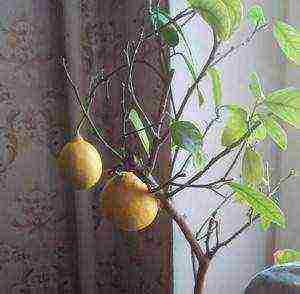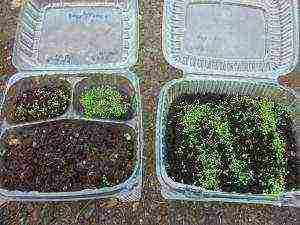Content
Many owners of household farms are engaged in breeding mute ducks (musky ducks).
The popularity of this breed is explained by its endurance and unpretentiousness: for breeding mute birds, a novice poultry breeder will only need a warm winter poultry house and a small walking space.
Features of the breed
Outwardly, mutees differ from other ducks: because of the bright red fleshy growths above the beak and a peculiar physique, they more resemble turkeys. Drakes of this breed reach 90 cm in length and weigh up to 4-6 kg. Females are smaller: their length is about 65 cm, and their weight is 1.8–3 kg.
Appearance and behavior
Mute ducks have a calm disposition and rarely get into fights with representatives of other breeds. Conflicts between birds arise in the event of a lack of food or due to improperly organized daylight hours (too long lighting leads to cases of pecking and cannibalism).
Features of musk ducks:
- squat, elongated body with a long tail;
- wide chest and short muscular neck;
- powerful wings and legs with sharp claws and rounded membranes;
- not very wide beak with a curved tip;
- smooth fleshy growths around the eyes and beak;
- bluish, brown, black, white or black and white.
Females differ from males in smaller size and a minimum amount of red-brown growths above the beak and eyes. In addition, the head of the female is smooth, and the head of the adult male is covered with raised, slightly puffy feathers.
Breeding orientation
 Muscovy ducks get the best dietary meat. It is distinguished by a low fat content and the absence of the specific smell characteristic of waterfowl meat. Slaughter takes place on 84 (for males) or 77 (for females) days; slaughter yield is 8-10% higher than that of other breeds.
Muscovy ducks get the best dietary meat. It is distinguished by a low fat content and the absence of the specific smell characteristic of waterfowl meat. Slaughter takes place on 84 (for males) or 77 (for females) days; slaughter yield is 8-10% higher than that of other breeds.
A female mute duck produces up to 70–100 eggs per year (each weighing 75–85 g). In terms of quality and nutritional value, they are similar to chicken. The bird flies daily for 5 months in spring and autumn. In summer and winter, she begins to molt; then the female rests and does not rush.
Breeding and raising ducklings
To get healthy offspring, the owner of the farm must select several individuals suitable for breeding in advance. For 3-4 well-laid females, 1 drake is required.
Laying hens and drakes
At the age of 180 days, the females selected for breeding are placed in a separate room and the daylight hours are gradually increased. By the time of laying, it should be 16-17 hours. Lighting intensity - 2-3 watts per 1 m2.
Eggs for incubation are selected in the spring, because from April to June, drakes have a peak of sexual activity and egg fertilization increases to 95% (the standard proportion of fertilized eggs in other periods is 50-60%).
It is necessary to carefully select birds for the broodstock, since as a result of closely related relationships, ducklings with pathologies and mutations appear. In order to prevent the degeneration of the breed, drakes should be regularly updated.
Incubating eggs
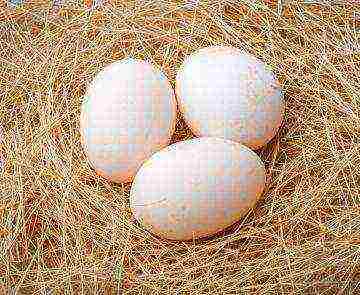 The best way to breed ducklings is natural incubation, in which 90% of the eggs hatch into ducklings. For the female to sit on the eggs, they do not need to be taken from the nest within 2 days. On day 3, eggs should be placed in the nest, which were selected earlier and stored at a temperature not higher than 11 ° C.
The best way to breed ducklings is natural incubation, in which 90% of the eggs hatch into ducklings. For the female to sit on the eggs, they do not need to be taken from the nest within 2 days. On day 3, eggs should be placed in the nest, which were selected earlier and stored at a temperature not higher than 11 ° C.
When there are 10-14 eggs in the nest, the female will begin to incubate them. There should be a feeder and a wide drinker near the hen's nest, where the bird can wet the feathers to water the eggs. Chicks hatch after 32–35 days.
Breeding in incubators
With artificial incubation, the percentage of hatched chicks is low. This is due to the fact that the eggs are covered with an impermeable membrane, which is poorly permeable to air and hinders the development of the embryo. The brood hen, interacting with the eggs, gradually removes this layer; when using an incubator, the process becomes more difficult.
Features of hatching chicks in an incubator:
- eggs are laid horizontally in an incubator heated to 38 ° C;
- the temperature is reduced gradually: 1-7 days - 38 ° C, 8-29 days - 37.6 ° C, 30-35 days - 37.2 ° C;
- humidity is regulated: 1–7 days - 55–60%, 8–29 days - 40–45%, 30–35 days - 70–75%;
- from day 15, the eggs are cooled: the incubator is opened for 10-15 minutes, and then the eggs are sprayed with a warm 30% solution of potassium permanganate;
- automatic egg turning is carried out hourly until the 30th day.
To remove the outer shells, the eggs are wiped with a napkin or soft cloth after irrigation.
Feeding ducklings
For the first time, the ducklings are fed with finely chopped boiled eggs, which are poured onto the backs of the chicks. On the second day, cottage cheese and milk are added to the food (they can be fed up to a month). From day 4, the diet includes greens (onions, spinach, beet tops), meat waste, bran and grains. On day 10, potatoes and grain waste are added.
Mineral feeding is also important. Chalk or shells, bone meal, yeast, cake and table salt are added to the food of the ducklings.
Keeping ducklings
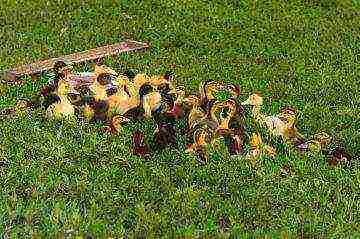 After hatching, the ducklings are taken away from the female and sent to a small box equipped with a heating pad and a red lamp and lined with straw or shavings. In the first week of life, ducklings need round-the-clock lighting with an intensity of 10 watts per 1 m2, then 5 watts. Daylight hours are reduced from 2 weeks to 16-18 hours, from 3 weeks - to 10 hours, from 8 weeks - to 8 hours.
After hatching, the ducklings are taken away from the female and sent to a small box equipped with a heating pad and a red lamp and lined with straw or shavings. In the first week of life, ducklings need round-the-clock lighting with an intensity of 10 watts per 1 m2, then 5 watts. Daylight hours are reduced from 2 weeks to 16-18 hours, from 3 weeks - to 10 hours, from 8 weeks - to 8 hours.
At day old, the metacarpus of one wing is cut off in ducklings, and after 2-3 weeks - the upper part of the beak. At the age of 2 weeks, females and males are seated in separate rooms (males can be easily distinguished by weight: at this age they weigh 30–35% more than females). At the same time, no more than 6-8 ducklings are located per 1 m2.
After 13 weeks, mute ducklings gain up to 3 kg of weight, after which they can be sent for slaughter.
Conditions of maintenance and care
Ducks are kept in warm poultry houses, the floor of which is covered with a mesh with cells of 20 × 20 mm and a rod thickness of 2 mm. The floor should be raised 25–30 cm above the ground and covered with a thick layer of bedding. Daily cleaning is not required in this area, but as the litter becomes dirty, add new straw or shavings to the house.
The duck room should contain:
- metal or wooden feeders (separate for dry and wet feed);
- freely accessible drinkers (it is better to place them at a low height so that the bird can easily submerge its beak);
- nests for brood hens lined with fresh dry straw;
- perches-logs 15–20 cm wide, located 15–20 cm from the floor and 30–35 cm from the wall.
The temperature in the poultry house should not fall below 15 ° C (during the laying period - at least 20 ° C). Lighting should be natural (using windows) or artificial (using orange-red lamps). The stocking density of adult birds should not exceed 2.5–3 heads per 1 m2.
Birds should have the opportunity to be outdoors (at least 30 minutes daily), so there should be a yard near the house for walking.It should be fenced and covered with a net to protect the ducks from predatory animals and birds. In summer, birds will receive half of the required amount of food in the yard.
Newcastle disease in chickens
almost impossible to cure, can only be prevented by vaccination.
For what purposes is it worth getting a Linda gum? We talked about it here.
What are the symptoms of Marek's disease and how can it be cured? Read in our article.
Diseases
Mute ducks are unpretentious and rarely get sick. If the house is dry and clean, and the birds do not live in crowded conditions, the spread of disease in the flock is rare.
Muscovy ducks suffer from the following diseases:
- aspergillosis;
- blockage and inflammation of the goiter;
- inflammation of the cloaca;
- downy eaters;
- vitamin deficiency A and E;
- cuticulitis (occurs in ducklings up to 1 month old).
To prevent an outbreak of the disease, it is necessary to observe hygiene in the poultry house, disinfect feeders and drinkers, feed the birds with balanced feed and isolate individuals with signs of the disease in time. To reduce the risk of infection, it is worth adding a weak solution of potassium permanganate to the birds' drinkers.
.
The muscovy duck is an independent species of wood ducks, and has nothing to do with turkeys. The original appearance, an unusual growth around the beak, dietary meat that does not have a specific taste, large tasty eggs, unpretentiousness, calm character and endurance - these are the characteristics that distinguish the representatives of this breed from other types of ducks. They facilitate keeping and caring for the birds. Unlike other breeds, the muscovy duck does not know how to scream - it only starts hissing softly when it senses danger. The maintenance and breeding of ducks at home is widely used, in which they rush well.
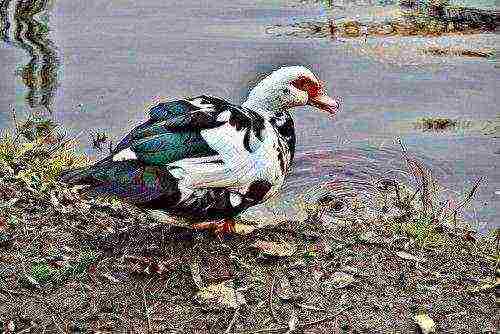
The muscovy duck is a species of woody ducks
The history of the breed
The description of these birds is found in ancient documents, when the Aztecs domesticated the Indo-female. They were called musky because these birds have a fleshy growth in the head area, from which fat is released, emitting a musky smell, by which they are easy to distinguish. It is also said that the ducks were so named, based on the fact that they were tamed by the Colombian Indians and kept at home. In European countries, the breeding and keeping of these birds began with the light hand of Elizabeth 1. The muscovy duck was brought to the Soviet Union in the early 80s of the last century from Germany, and in the late 80s - from France, in which they received the name “barbarian ducks ".
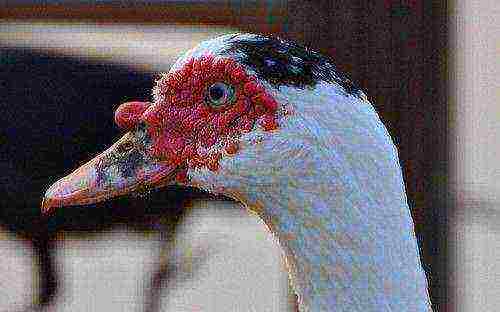
Muscovy duck has specific growths around the eyes
Features of appearance
Indo-ducks are original large birds with a short neck, broad chest, powerful wings and short legs. They are easy to distinguish from other bird species. They have excellent endurance, calm character, unpretentious organism and not susceptibility to any kind of disease. The muscovy duck is painted in dark, white, black, chocolate, brown, blue colors, which make it possible to distinguish it among a large number of waterfowl. You can find a drake of non-standard colors. Some scientists believe that mixed-colored ducks appear when they are bred with a mixture of breeds. As there are breeds, there are so many possible crossings.
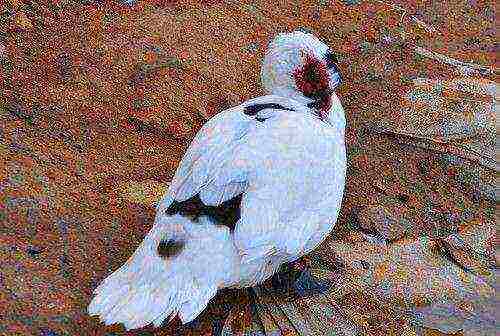
Muscovy ducks come in a wide variety of colors
The main characteristics of Indo-girls are
- Weight. A musky drake weighs up to 6 kg, and a female - no more than 3.5 kg.
- Meat. Indo-women are famous for a large amount of dietary red meat, the fat content in it is low. The brisket is the tastiest part. The meat does not have a specific taste that is inherent in all waterfowl. Most often they are grown for slaughter - breeding for the sake of obtaining tasty meat.
- Eggs. The eggs are tasty, large in size, large yolk and high quality protein. The duck can be carried every day.
The breed has its merits and demerits.
Ducks have the following advantages:
- Unpretentiousness to the stern.
- Endurance.
- High productivity of the drake.
- The ability to do without a reservoir for a long time.
- Not noisy and not pugnacious birds.
- Possession of the instinct of incubating eggs - the female sits on the eggs until the chicks hatch.
The disadvantages of the breed include:
- Impossibility of living in damp conditions.
- Intolerance to tightness.
- Duration of growth.
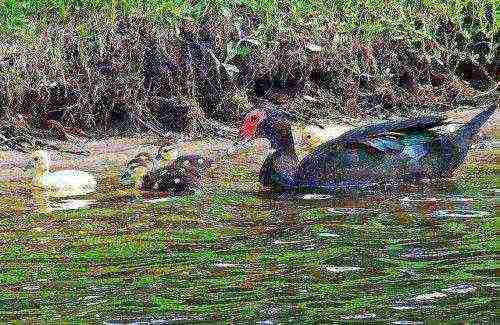
Muscovy ducks have a well-developed parental instinct
Ducks are susceptible to disease
- The presence of downy eaters.
- Goiter catarrh.
- Inflammation of the cloaca.
- The presence of a perverse appetite - gluttony.
With a timely detection of a disease in a muscovy duck, getting rid of it quickly and easily. Keeping birds in a warm and dry environment can prevent disease. Birds also cannot stand extreme heat. Breeding them is advisable.
Features of maintenance and care
Muscovy ducks are kept at home in special ducklings. Since their habitats used to be a pleasant zone with a warm climate, the birds did not need to accumulate subcutaneous fat for warming. The presence of this individual feature is noticed today. This obliges people to create special conditions for ducks during the cold season. To do this, they build capital poultry houses, light, dry and protected from visits by other poultry and animals, capable of protecting the Indoor from sudden temperature changes.
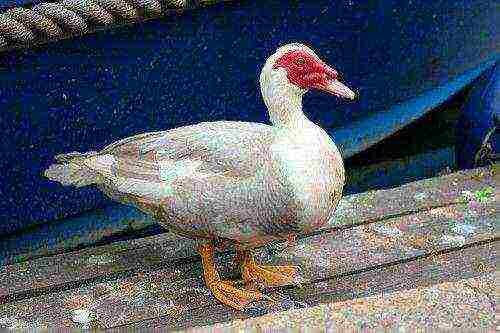
The muscovy duck does not like drafts and sudden temperature fluctuations.
For walks of birds, a place for a walking yard should be equipped. Muscovy ducks need to spend more time outdoors and not avoid sunbathing. The walking area should be fenced off with a high fence and covered with a net on top that protects the birds from predators and does not allow them to leave the walking yard.
Keeping and breeding ducks at home can be, and in the absence of large areas, birds are placed in wooden cages, or cages made of metal nets, installed in tiers.
With a large enough area:
- It is necessary to equip the duckhouse with mesh floors to simplify its cleaning.
- A good and deep non-replaceable bedding, equipped in the room, due to the biochemical processes taking place inside it, begins to generate heat, therefore additional heating is not needed. It also contributes to the destruction of pathogenic microbes.
- There is no need for daily cleaning in the room.
- You can add shavings or straw cuttings while fattening the ducks if the litter is dirty, calculating exactly how much is needed to get the litter dry.
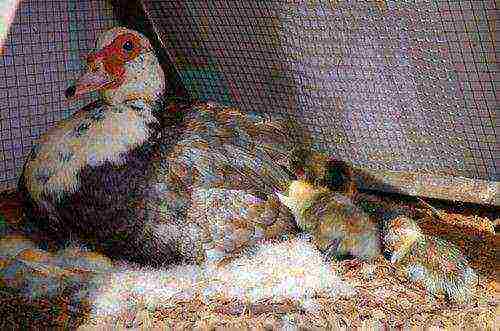
Irreplaceable bedding in the duck house itself warms its inhabitants
In the duckhouse, where the Indo-girls will have to rush, the following should be installed:
- Wooden, in which the dry mixture is placed, and metal, intended for wet feed, feeders. It is necessary to calculate exactly how many will be required.
- Drinking bowls, since the consumption of large volumes of liquid is one of the peculiarities of the Indo-duck's nutrition. The ducklings, after their appearance, begin to drink a lot, they must freely reach the water, therefore, the drinkers must be placed so that the beaks are completely immersed in the water. There should be as many drinkers as needed to ensure that the birds receive sufficient water.
- Nests in which the female sits, placed on the floor and lined with dry and fresh straw. You can make them like closed houses with holes located 10 cm from the floor. The hen requires a cozy and comfortable placement. Ducks rush in these nests.
- Roots in the form of logs, because this breed of ducks does not sit on the ground.
Raising ducklings without complying with standards is faced with multiple problems:
- Delays in the development and growth of babies.
- The onset of diseases.
- Sometimes even ducklings die.
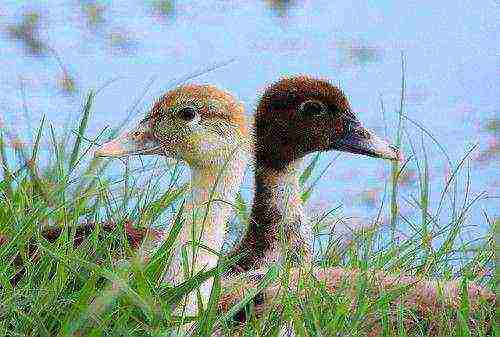
Muscovy ducklings require special conditions
Features of feeding mute ducks
Indoor is an omnivorous bird. The best food for them will be wet mash: chop fresh grass, mix with beet tops, kitchen waste and grain. The best delicacy of this breed is corn. It is recommended to soak barley grains first. By their simplicity in the use of food, mute birds can be distinguished from other species of birds.
This breed consumes less fodder than its counterparts of other breeds. And if you are near a reservoir, you can stop worrying about proper and abundant feeding, since these birds begin to feed on a variety of insects and worms.
For greater productivity, ducks require thoughtful and balanced nutrition - the use of feed with mineral feed, as much water as possible.
There are some subtleties associated with nutrition and care:
- Representatives of this breed love to collect and swallow anything that glitters: glass shards, nails and small metal objects. Therefore, it is necessary to maintain cleanliness in the room and the reservoir, providing the birds with good care and maintenance.
- Extremely hot water or food is harmful to birds.
- Do not keep representatives of this breed in one place with other birds.
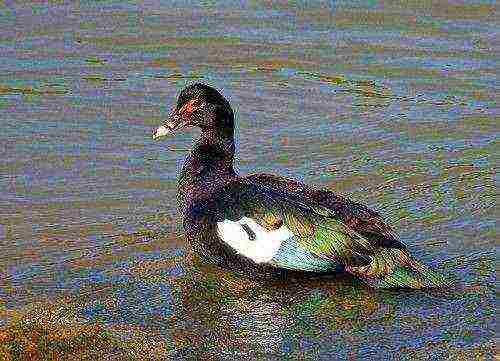
Care should be taken to ensure that the water in the duck pond does not stagnate.
What you need to know about laying ducks
Domestic ducks begin to rush when they reach the age of 5 months, but for this it must be kept in a warm and spacious duckhouse. It would be better to rush an Indo-woman born in the fall.
A moderately well-fed and not overfed female, with smooth and silky feathers, with paws and beak that have a bright orange color, is healthy and will run well.
Sometimes females leave their nests and then return. They are very picky about the place where they are going to lay, so you should not force her to sit strong on the eggs. Birds like to nest in nests that are quiet, cool and shaded. Do not approach the female at this time, so as not to frighten her.

The muscovy duck takes care of the offspring, but it is important not to scare her
Features of breeding and cultivation
If the eggs are left in the nest for two days, the maternal instinct will wake up in the Indo-duck. Indo-Ducks lay eggs in a certain cycle. The first cycle is five months, then their molt continues for three months. A drake and four well-bearing females are used to breed offspring. Closely related interbreeding causes mutations and pathology in chicks.
How much delicious meat will come from a duck obtained from crossing an Indo-Duck with Peking females, if you provide them with proper care and maintenance!
The resulting poultry does not have the ability to reproduce, but their breeding and growing allows the meat to be used for preparing dietary meals.
Ducks hatch poorly only in an incubator, since eggs laid in a horizontal position are covered with dense shells that do not allow air to pass through. Incubation of duck ducks: a certain temperature and humidity is maintained in the incubator for about 15 days, and the next half of the incubation is carried out at slightly reduced temperature and humidity in the incubator, the eggs are sprayed with water twice a day. A table with the required temperature changes is displayed.
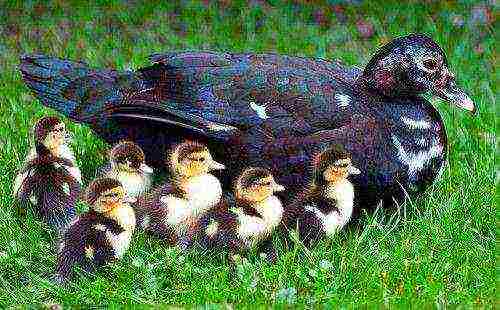
Muscovy duck has a maternal instinct if eggs are in the nest for more than 2 days
Raising ducklings is carried out without maternal care in an incubator, if at an early age they are protected from moisture and coolness, and they must be fed correctly. Teaching babies to eat is not difficult. First, you need to feed them yourself, give them a slightly pink solution of potassium permanganate from a pipette, and then cut the boiled egg. Ducklings respond better to live food, so you can sprinkle crumbled eggs on their backs. The next day, you can feed the ducklings a semi-liquid porridge made from milk and eggs with added bran. Gradually, the diet of babies is diversified with cottage cheese, finely chopped onions, spinach, green beet tops. There is a table showing how to gradually change the diet of chicks, how much feed they should give them, and what kind of care they should be. Do not be intimidated by the liquid droppings of birds - this is a feature of their body.
When the offspring is incubated by the female at home, the hen itself begins to remove unnecessary shells from the eggs, thereby improving gas exchange and accelerating the development of the fetus. Chicks hatch most often after 32 days. The ducklings are taken away from their mother, and their rearing continues in a heated box, the bottom of which is covered with straw, the floor is warmed by a heating pad, and a lamp is installed on top. It is necessary to feed them, adhering to a special system, providing the chicks with care and attention. As far as proper care is provided, the faster the chicks begin to grow.
Subscribe Be aware of new products on our site
The domestic duck is one of the most economical farm birds. Especially where there are meadows and reservoirs, where the bird can get by with detailed food, the duck is especially popular. Therefore, there are more and more people who want to make money on the duck business. Many seasoned farmers claim that breeding and keeping these birds is a simple and profitable business.
However, a novice amateur poultry breeder faces many problems: what breed to choose for growing, how to feed and keep birds at home. For a start, you can practice on a small number of livestock. In building your small business plan, the main thing is to determine which goal you are pursuing to a greater extent. Ducks can be bred for the purpose of obtaining meat, egg or breeding direction for the sale of young animals. If you decide to go into meat products, then for these purposes a muscovy duck or not so long ago bred mularda ducks will suit you. Musk birds appear more and more often in rural yards. They attract amateur poultry farmers not only with their healthy and tasty meat, but also with their exotic look. In general, this is not a bad business that does not require significant costs. To begin with, you will need to purchase livestock, feed, vitamin supplements, antibiotics (for treatment) and decide on a place for growing poultry. If you own a summer cottage or some other personal plot, this will make your task easier. It should only be remembered that for greater success, your small business must have a closed cycle, bring you income throughout the year. That is, when raising ducks, in spring you will have a demand for adult breeding males and females, at the beginning of summer - for diurnal ducklings. In autumn and winter, the slaughter of poultry for meat begins. Plus, you can sell eggs.
general characteristics
It is believed that after the wild goose was tamed, man decided to forcibly also the mallard, the ancestor of our domestic duck. Domestication of the wild duck has taken place in different places and over different periods of time. The musk duck is the only breed that emerged from a wild species that lives in South America, which to this day successfully exists in Brazil and Paraguay. It is believed that the bird acquired its name because of the musky smell that permeates its skin.
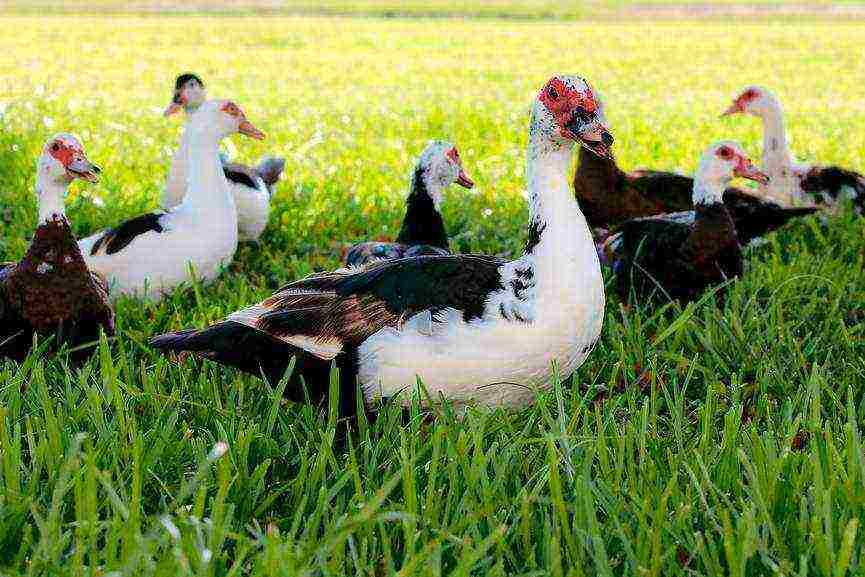
Muscovy ducks have a very peculiar appearance and are in many ways unlike their relatives. In combination with a wide chest and small neck, musky ducks are characterized by large, strong wings, close to an elongated and rather wide body without a pronounced tunic. The head is large. And ducks walk on short legs, which have long and sharp claws.
The domesticated musk duck is virtually indistinguishable from its wild cousin. The plumage of the bird is mainly of a wild color: from above it has black plumage, from below it is dominated by brown color with a light rectangular spot on the wing. But, you can also find in the poultry yard and individuals of a brighter color, for example, white, black or variegated color, gray-pearl, smoky or tortoiseshell color. Males have a large crest on their heads. Some believe that muscovy ducks were obtained by crossing a common mallard with a turkey, due to the fact that the musk duck, like a turkey, has a bare face with large pink-red warts and a fleshy formation at the base of the beak. However, it is not. This is an independent species of birds, although it received the name for its resemblance to a turkey - an indowka. And for the extraordinary behavior that the Indo-Dogs differ from other breeds, they were nicknamed Mute. The fact is that the musky representatives do not quack, but hiss like snakes. You can observe in the poultry yard how importantly they bow when they meet each other, and, hissing, disperse. There is a wide variety of Indo-Duck breeds. They do not have a big difference in the structure and quality of products, the main distinguishing feature is their different plumage. Distinguish between white, black, brown-white, wild brown, blue, white with a pattern of musk ducks. The least common in the poultry yard is the blue Indoor.
The weight of a musky drake of any breed for a three-month period of rearing is close to 6 kg, of a female - to 2.5 kg. Egg production - 80-90 eggs, each weighing about 78 grams.
Keeping ducks at home
Any room is suitable for growing adult poultry at home, the main thing is that it is dry and warm and corresponds to the area that is needed for the free movement of the bird, and the technology of its maintenance has been observed. The main thing for ducks is space. Most of all, they cannot stand tightness. As you know, these birds, possessing a kind of sluggishness, will not jump anywhere and will not jump in order to escape from the constant crush even for a moment. The duck, in comparison with other representatives of birds, needs five times more oxygen, and water - 2-3 times more chicken. And she does not eat in the same way as birds do. Duck grab food and immediately run to the water to immediately wash down what they have eaten. And in cramped conditions, as a rule, you will not accelerate very much. And if you take into account that ducks do not row with their paws like chickens, but rather trample down the bedding, then with a massive amount of poultry rearing, your ducklings can turn into a swamp. Therefore, when breeding ducks, taking into account their peculiar features, you should correctly calculate the area where you are going to keep it. Adhere to the following rules. By technology for 1 sq. meter of floor is placed no more than three Indoor. And the walking area should be two meters more, within five square meters. meters per individual. That is, failure to comply with such requirements can adversely affect the condition of your bird. And this, in turn, will lead to a deterioration in the development of your business.
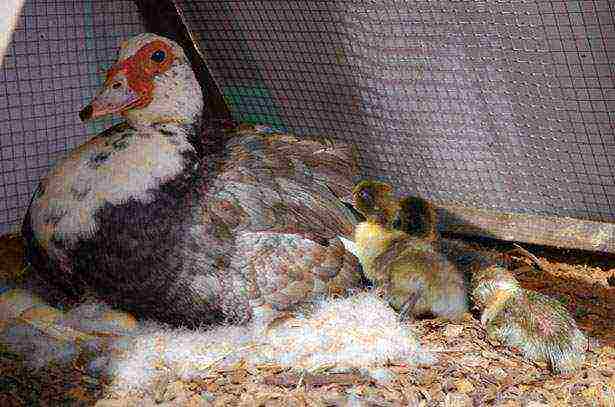
Growing and breeding muscovy ducks requires a greenhouse environment. Indo-women are very sensitive to cold. When the air temperature drops by only 5 ° C, the productivity of the bird decreases by 15-20%. Therefore, in winter, Indo-Ducks must be kept in poultry houses with a temperature of at least 16 ° C. Straw is used as a bedding material for insulation. These ducks do not tolerate dampness in the room. The humidity in the room where the ducks are kept should not exceed 60-70% all year round. Therefore, in order to adhere to such norms, with the onset of cold weather, the ducklings must be heated, and in the summer, especially in extreme heat, irrigate or increase the humidity by hanging a wet cloth in the room.In order to avoid wetting the floors, it would be prudent to equip part of the floor of the house with mute ducks with a mesh with a mesh size of 24 × 24 or 24 × 30. Such mesh floors are usually installed along the entire length of the duckhouse above the bed box. The feeders are placed on the bedding, and the containers with water are on mesh floors, taking into account the gap between them about 3 meters, in order to provide the bird with enough space to avoid crushing, as already mentioned. Lighting plays an important role in bird productivity. Daylight hours should be about 14 hours. Taking into account the short day in winter, you should take care of artificial lighting in the room with mute. For this purpose, the poultry house is supplied with electric bulbs at the rate of 5 W per 1 sq. m of floor area. For better efficiency, reflectors can be attached to the bulbs. Feeders are constructed from wooden planks. In the form of a barrier, which serves to prevent the bird from getting into it and not spoiling the feed mixture, a plank is placed on them, which in parallel also plays the role of a handle. It is better to make a feeder for mineral feeding with two or three compartments. This will make it easier for you when separating different types of feed. Water tanks can also be crafted from wooden planks. For sleeping and laying eggs, the bird should be provided with nests. The size of one nest is 40 × 50, and the height is 8-10 cm. In this size of the nest, no more than three individuals can be accommodated. The walking area for ducks is separated by a metal mesh. In the absence of such, a branka, wooden planks, brushwood and even a net for fishing are suitable. The height above the ground level of such a fence can be no more than a meter, even taking into account the fact that the mutees fly well. This problem is solved by cutting, perhaps even one wing of the bird. This should be done until the bird stops trying to take off.
When growing Indo-Ducks on reservoirs, although, in principle, mute ducks can do without them, ducklings are installed at a distance of at least 100 meters from each other. The length of the coastline near the poultry house, for example, for 500 heads, is also measured at least 100 meters. One mute should be allocated 25-30 square meters. meters of water surface. The advantage of having a pond on the territory of the walk is saving your costs in the business of raising ducks by about 20%, since your bird will eat additional food from the ponds. They willingly feast on duckweed, lily, elodea, water buckwheat, and even frogs, small crustaceans and various aquatic insects.
The room where the bird is kept must be clean and well ventilated. Since ducks lay at night or in the morning, it is better not to release the bird until 10 am in order to avoid the possibility of losing eggs while walking.
Feeding Indo-Dogs at Home
In nutrition, these are rather not picky and gluttonous birds. However, a well-formulated diet for your ducks will affect a good selection of poultry meat and its productivity, and will also be the key to the success of your business. You should be aware that nutrients are used by the body in different amounts depending on the season, care and well-being of the bird itself. When drawing up the menu, you should also take into account that an excess or shortage of one of the components will attract as a result a failure in the absorption of other nutrients. A well-combined diet must comply with the following rules:
- it must meet the needs of the bird;
- he must be eaten with appetite;
- its volume should correspond to the capacity of the digestive organs, since a lack or excess of food in the stomach leads to malfunctions of its motor activity;
- the diet should include more affordable and not scarce feed, which is important for your business, since the main costs of raising poultry are spent on feed.
An economically profitable way of organizing full-fledged feeding of ducks is a combined type of feeding, in which 45% of grain feeds of daily consumption are fed unmilled, the rest in the form of mash together with herbs, vegetables, root crops. Unmilled grain is fed during the evening feeding. With the combined type of feeding, which, as you already understood, consists of dry and moist feed, the dry type of feed can be in the feeders regularly, but the moist feed can be distributed several times a day, in such a volume that the bird eats it within 45 minutes , since such moist mash in summer is subject to very rapid souring, and in winter it freezes. With a moistened type of feeding, the crushed concentrated feed can be moistened with water, milk, liquid food residues, chopped juicy feed, meat and fish washes.
Cereals with a high carbohydrate content in terms of quantity and calorie content form the basis of nutrition for poultry rearing. By their composition, they are an excellent source of a large amount of carbohydrates, protein, fat, and minerals. As cereals, Indo-women can be given corn, barley, wheat. According to the technology, corn is fed to poultry, in a milled state, barley can be given whole to an adult bird, and chicks in a crushed form to the state of flour, and feed wheat is fed to a bird in the form of cereals, since in a smaller fraction, when mixed, it will look like glue and stick in the mouth of birds.
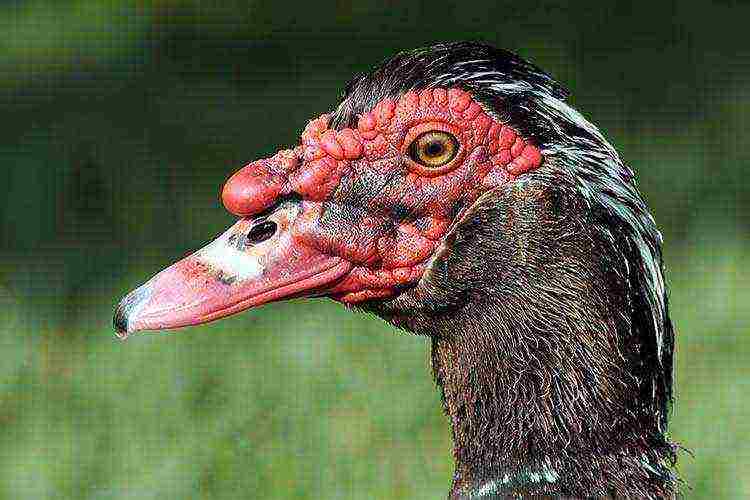
It is better to give green grass to ducks freshly cut. Greens are a source of carotene, a complex of vitamins, partly protein. Indo-duck menus may include alfalfa, clover, dandelion, nettle, quinoa.
As vegetables, potatoes, carrots, cabbage, beets and pumpkin are added to the mash for ducks. Potato tubers are peeled and boiled in slightly salted water, then kneaded and mixed with other components of the feed mixture. Carrots, cabbage, beets and pumpkin (zucchini, squash) are pre-washed, cleaned of dirt and fed raw, grated. You can also add oil cake, meal and bran to the mash. Oilcake and meal in their composition contain in the largest part protein, vegetable fats, phosphorus and potassium. Such feed additives play an important role in enriching the bird's body with deficient amino acids. The bran is used to enrich the body with phosphorus and vitamins B. Feed and animal origin are indispensable for the development of poultry. These include fish, milk, fish, meat, meat and bone, blood, feather meal and fish oil. Fresh fish is pre-boiled before feeding, crushed and accumulated in moist mash. Feather meal is a must on the poultry menu when moulting. Milk is a product mainly in the diet of young animals. It should only be leavened. In addition to sour milk, they feed curdled milk, cottage cheese, cheese curd. For an optimal calcium content in the blood of a bird, as well as the formation of a solid egg shell, mineral additives should be present in the ducks menu: table salt, lime tuff, shell, lake silt, chalk, eggshell.
Who are the mulards
Mulard are broiler ducks, were obtained by crossing musk and Peking ducks. To develop a new type, a person was pushed by the desire to eradicate the shortcomings that musky ducks have. For all their unpretentiousness in food and calm disposition, mute ducks also have their disadvantages: thermophilicity, late maturity, high incubation instinct, prolonged weight gain and small size of females. Egg production in muscovy ducks begins at the age of 6.5 months, which proceeds in cycles of five months of laying and three months off. From their ancestors, the Peking ducks, the mulards inherited resistance to high temperatures, early maturity, fertility and a low need for incubation.Plus, mulard meat attracts gourmets due to its low fat content, and is similar to the spicy taste of game. The carcass of mulard after about two months gains a weight of about 5-6 kg when using feed for one kilogram of weight gain of 2.3-3 kg. And a distinctive feature of them from muscovy ducks is that even female mulardov ultimately have almost the same meat yield as drakes (with a difference of about 0.5 kg) with such a diet.
As a result, this mularda broiler breed, no matter how better, is suitable for growing for those who want to make good money on the duck business, even at home.
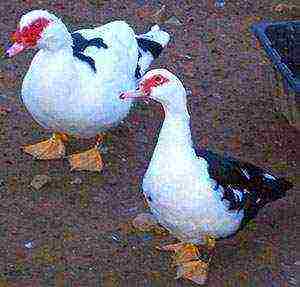 The rural backyard is always filled with a variety of animals. Breeding duck ducks is beneficial for many reasons. Calm birds in summer get half of their feed themselves with free grazing. The living conditions are a small pond and a green lawn in the summer, a warm winter hut in the winter. Slaughter weight is fattened up to the first molt, 13 weeks.
The rural backyard is always filled with a variety of animals. Breeding duck ducks is beneficial for many reasons. Calm birds in summer get half of their feed themselves with free grazing. The living conditions are a small pond and a green lawn in the summer, a warm winter hut in the winter. Slaughter weight is fattened up to the first molt, 13 weeks.
The origin and characteristics of the breed
 Wood ducks, and this is how they were called among the ancient Aztecs, they tamed. The bird received other names from people:
Wood ducks, and this is how they were called among the ancient Aztecs, they tamed. The bird received other names from people:
- musky, for a specific smell from growths around the eyes;
- mute, for inability to shout loudly;
- Indo-duck is a duck from the Indians.
The musk duck is characterized by equanimity. She has a wide chest and short legs. The bird's wings are very powerful with beautiful plumage. They can be white and chocolate, there are even blue and two-color, variegated.
The advantages of mute ducks include:
- unpretentiousness in the choice of feed;
- they do not arrange noisy showdowns with other inhabitants of the courtyard;
- can do without reservoirs;
- rarely get sick.
The requirements that must be observed in the conditions of keeping ducks include - avoid dampness in the room, and space - a square meter for 3 individuals. But even in winter, in the snow, birds must take sun baths every day for half an hour. By the time the eggs are laid in April, it is necessary to gradually create a 16-hour light period for them by supplementary lighting. It is no longer possible, cannibalism will wake up in relation to the hatched ducklings.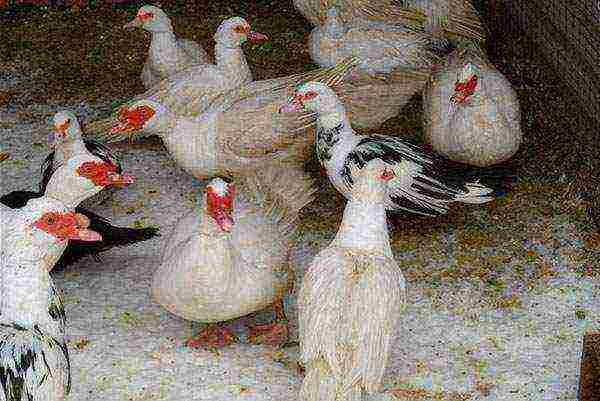
The homemade musk duck is prized for its calm character and unpretentiousness in food. In a short time, the ducklings grow up, and from three months they can provide their family with tender dietary meat. An adult drake weighs 6, a duck - about 3 kg. They are not fatty, they have red meat.
The peculiarity of Indo-Ducks is the ability to swallow everything that glitters. They can collect sharp glass fragments, scattered self-tapping screws, and then suffer from obstruction. Where Indo-girls go, there must be cleanliness.
Indo-duck eggs are large, weighing up to 85 g. They rush in two periods, in spring and autumn. During the moulting period, ducks rest. In just a year, you can get 70-100 eggs. In order for the eggs to be fertilized, one drake is needed for 4-5 females. Muscovy ducks are bred from spring clutches, and the earlier the eggs are taken for hatching, the greater the hatching percentage. Incubation lasts 32-35 days under the brood hen. In the incubator, you need to follow some tricks in order to get fewer frogs, but more males are hatched in it, which is good for breeding ducklings for meat.
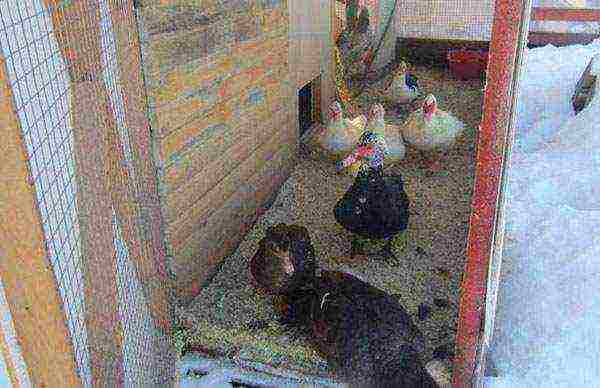 It is important to know that in summer, muscovy ducks will be satisfied with keeping in a light shed with logs for the night. In winter, you need to have a room with warm dry bedding and perches. The temperature of the content should be at least 15, for ducklings above 20 0 C. In warm weather, birds should peck on grass, everything that creeps in it and get duckweed, larvae, crustaceans in a nearby reservoir. Due to this, the muscovy duck at home eats 50% less than the food required for the diet.
It is important to know that in summer, muscovy ducks will be satisfied with keeping in a light shed with logs for the night. In winter, you need to have a room with warm dry bedding and perches. The temperature of the content should be at least 15, for ducklings above 20 0 C. In warm weather, birds should peck on grass, everything that creeps in it and get duckweed, larvae, crustaceans in a nearby reservoir. Due to this, the muscovy duck at home eats 50% less than the food required for the diet.
Conditions for obtaining offspring at home
To obtain ducklings, fertilized eggs of the first days of laying are taken. It is necessary to select eggs that are complete in appearance. They must be clean, of a characteristic shape and of approximately the same weight.The material is collected for incubation within 2 weeks, stored at a temperature of 110 C on the side. At the same time, ducklings hatch faster from earlier eggs.
Brood brood ducks
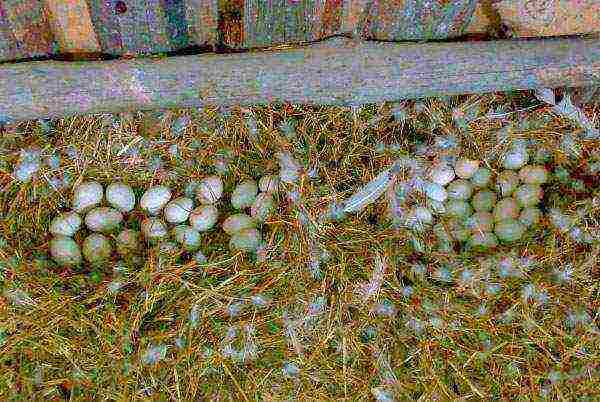 With natural dilution, it is best to separate the mother liquor. A drake and 3-4 ducks are brought into a prepared separate room. Secluded places are necessarily created and dry leaves or sawdust are left.
With natural dilution, it is best to separate the mother liquor. A drake and 3-4 ducks are brought into a prepared separate room. Secluded places are necessarily created and dry leaves or sawdust are left.
Eggs laid by a duck must not be touched. The bird itself knows what to do.
Muscovy ducks are good brood hens, they sit on the nest when more than 10 eggs have accumulated in it. The embryo development period is 32-35 days. During this time, the mother duck repeatedly turns the eggs, sprinkles them with water brought in from the trough in the beak, removes the thick shell layer by layer so that air can enter the chamber. Under these conditions, the yield from the clutch is about 90%.
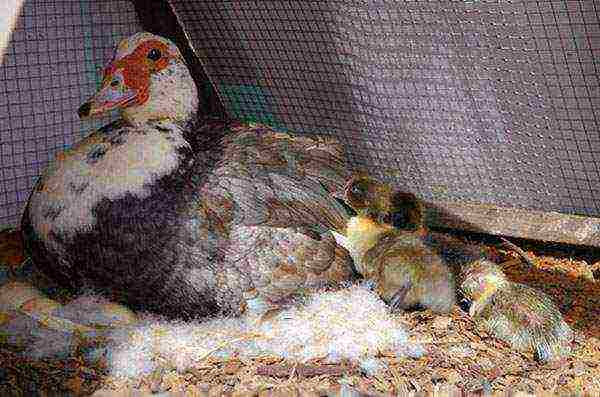 The first ducklings that come out when breeding with a musky duck, without human help, can freeze or die of hunger. The hen continues to sit, not paying attention to the babies. They should be placed in a warm box heated by incandescent lamps, allowed to dry and taught to peck. Ducklings can only grab food in motion. Therefore, crumbs of a hard-boiled egg are poured onto the backs of the chicks. The ducklings move, the food rolls down, and the kids catch it in the fall. So they learn to eat on the first day.
The first ducklings that come out when breeding with a musky duck, without human help, can freeze or die of hunger. The hen continues to sit, not paying attention to the babies. They should be placed in a warm box heated by incandescent lamps, allowed to dry and taught to peck. Ducklings can only grab food in motion. Therefore, crumbs of a hard-boiled egg are poured onto the backs of the chicks. The ducklings move, the food rolls down, and the kids catch it in the fall. So they learn to eat on the first day.
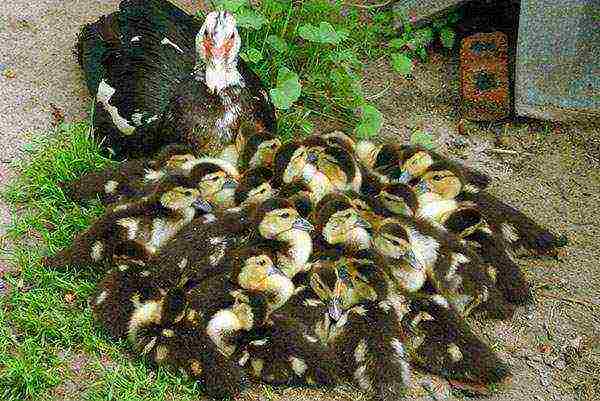 After 35 days of incubation, eggs with undeveloped embryos are harvested, and the duck will take care of the brood. For this, dried and warmed ducklings are again planted with the duck in the evening. In the morning she leads the ducklings to the courtyard, and in a week they will already be swimming. Before that, the mother duck will carefully lubricate the feathers with fat so that the chicks do not get wet and drown.
After 35 days of incubation, eggs with undeveloped embryos are harvested, and the duck will take care of the brood. For this, dried and warmed ducklings are again planted with the duck in the evening. In the morning she leads the ducklings to the courtyard, and in a week they will already be swimming. Before that, the mother duck will carefully lubricate the feathers with fat so that the chicks do not get wet and drown.
Breeding ducklings in an incubator
In an incubator preheated to 38 degrees, the largest eggs are laid in a horizontal position, after 5 hours - medium ones, after the same amount - small ones. Twice a day, the laid material is sprayed with a slightly pink warm solution of potassium permanganate to cool and accelerate metabolism. Wet eggs are wiped with napkins, removing the top layer of a thick peel instead of a brood hen. For cooling, you can simply open the lid for 30 minutes, as if the hen went to eat.
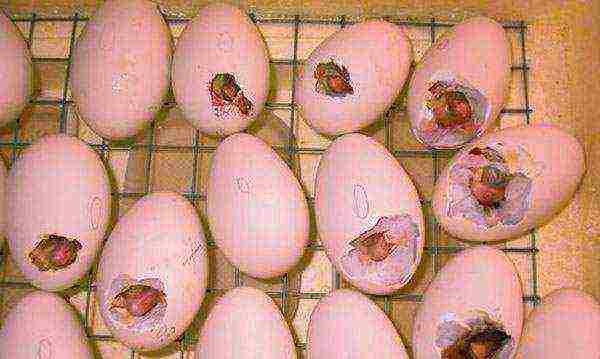 The turning of the eggs is done automatically or manually. At the same time, to average the temperature of development, the clutch must be interchanged, shifting the outermost eggs to the center. The temperature in the chamber is gradually lowered, the coups are made by a certain degree, according to the table. Incubation of duck ducks lasts 32-35 days.
The turning of the eggs is done automatically or manually. At the same time, to average the temperature of development, the clutch must be interchanged, shifting the outermost eggs to the center. The temperature in the chamber is gradually lowered, the coups are made by a certain degree, according to the table. Incubation of duck ducks lasts 32-35 days.
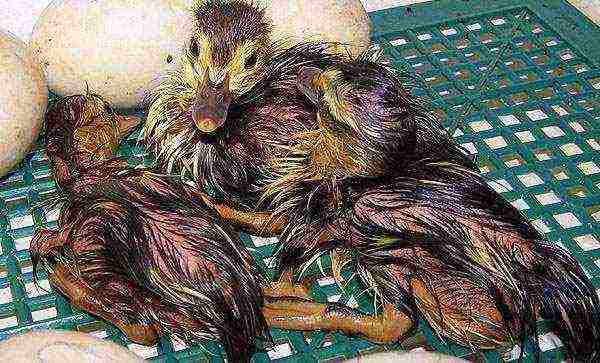 After that, the brood is placed in a brooder and care is organized. Especially responsible for the first 10 days. Ducklings are taught to feed gradually. There is no need to be afraid of liquid droppings, this is a feature of Indo-duck chicks.
After that, the brood is placed in a brooder and care is organized. Especially responsible for the first 10 days. Ducklings are taught to feed gradually. There is no need to be afraid of liquid droppings, this is a feature of Indo-duck chicks.
When breeding muscovy ducks at home, do not let fledgling ducklings near the water. They will get wet and drown.
To grow females from five months, it is necessary, contrary to nature, to lengthen the daytime, gradually preparing them for egg-laying. By spring, the length of the day should be 16 hours. Then the productivity of females and their full fertilization will allow you to get strong offspring of musk ducks when breeding at home.
When feeding young animals for meat, it is necessary to create conditions for rapid growth. It is economically viable to feed for 13 weeks, or until molt. When the bird loses feathers, weight gain stops. Of the livestock, 60% are guaranteed drakes, they will gain 3 kg of weight by 13 weeks. The remaining livestock of females can be transferred to winter keeping and prepared for spring brood.
The subtleties of breeding muscovy ducks - video
